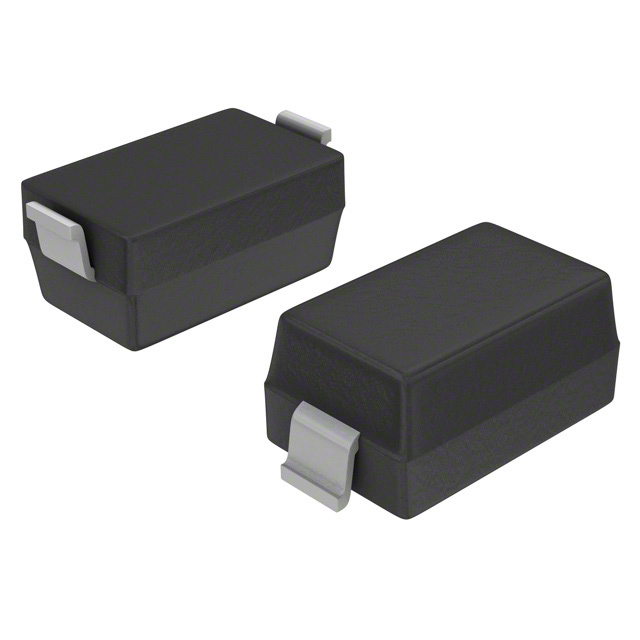Xem thông số kỹ thuật để biết chi tiết sản phẩm.

BZT52C9V1-7: Product Overview and Analysis
Introduction
The BZT52C9V1-7 is a vital component in the field of electronic engineering, belonging to the category of Zener diodes. This article provides an in-depth analysis of the BZT52C9V1-7, covering its basic information, specifications, pin configuration, functional features, advantages and disadvantages, working principles, application field plans, and alternative models.
Basic Information Overview
- Category: Zener Diode
- Use: Voltage regulation and protection in electronic circuits
- Characteristics: Precise voltage regulation, low leakage current, and high reliability
- Package: SOD-323
- Essence: Regulating voltage in electronic circuits
- Packaging/Quantity: Available in reels with varying quantities
Specifications
- Voltage: 9.1V
- Power Dissipation: 300mW
- Operating Temperature: -65°C to +150°C
- Zener Impedance: 40Ω
- Max Reverse Leakage Current: 100nA
Detailed Pin Configuration
The BZT52C9V1-7 Zener diode has a standard SOD-323 package with two pins. The cathode is connected to the positive terminal, while the anode is connected to the negative terminal.
Functional Features
- Precise Voltage Regulation: The BZT52C9V1-7 maintains a constant voltage across its terminals, ensuring stability in electronic circuits.
- Low Leakage Current: With a maximum reverse leakage current of 100nA, it minimizes power loss and enhances efficiency.
- High Reliability: It offers consistent performance over a wide range of operating conditions, making it suitable for various applications.
Advantages and Disadvantages
Advantages
- Reliable voltage regulation
- Low leakage current
- Compact SOD-323 package
- Wide operating temperature range
Disadvantages
- Limited power dissipation capability
- Higher zener impedance compared to some alternatives
Working Principles
The BZT52C9V1-7 operates based on the principle of the Zener effect, where it maintains a constant voltage drop across its terminals by allowing current to flow in reverse bias.
Detailed Application Field Plans
The BZT52C9V1-7 finds extensive use in various electronic applications, including: - Voltage regulation in power supplies - Overvoltage protection in communication systems - Signal clamping in audio amplifiers - Voltage reference in precision measurement equipment
Detailed and Complete Alternative Models
- BZX84C9V1: Similar voltage rating and package, lower zener impedance
- MM3Z9V1: Comparable characteristics, smaller SOD-523 package
- 1N4739A: Higher power dissipation, axial lead package
In conclusion, the BZT52C9V1-7 Zener diode plays a crucial role in voltage regulation and protection within electronic circuits. Its precise characteristics, compact package, and reliable performance make it a preferred choice for diverse applications in the field of electronic engineering.
[Word Count: 443]
Liệt kê 10 câu hỏi và câu trả lời thường gặp liên quan đến ứng dụng BZT52C9V1-7 trong giải pháp kỹ thuật
What is the BZT52C9V1-7?
- The BZT52C9V1-7 is a 9.1V Zener diode designed for voltage regulation and protection in various electronic circuits.
What are the typical applications of BZT52C9V1-7?
- It is commonly used in voltage reference, voltage clamping, and overvoltage protection circuits in electronic devices.
What is the maximum power dissipation of BZT52C9V1-7?
- The maximum power dissipation is typically around 300mW.
What is the maximum forward voltage of BZT52C9V1-7?
- The maximum forward voltage is usually around 1V at a forward current of 200mA.
What is the temperature coefficient of the BZT52C9V1-7?
- The temperature coefficient is typically around -2mV/°C.
What is the reverse leakage current of BZT52C9V1-7?
- The reverse leakage current is generally very low, typically in the range of nanoamperes.
Can BZT52C9V1-7 be used for voltage regulation in battery-powered devices?
- Yes, it can be used to regulate voltage in battery-powered devices to ensure stable operation.
Is BZT52C9V1-7 suitable for automotive electronics applications?
- Yes, it is suitable for automotive electronics due to its ability to provide overvoltage protection and voltage regulation.
What is the package type of BZT52C9V1-7?
- The BZT52C9V1-7 is typically available in a small surface-mount SOD-123 package.
Are there any specific layout considerations when using BZT52C9V1-7 in a circuit?
- It is important to minimize trace lengths and keep the device close to the load to reduce parasitic effects and ensure proper performance.

